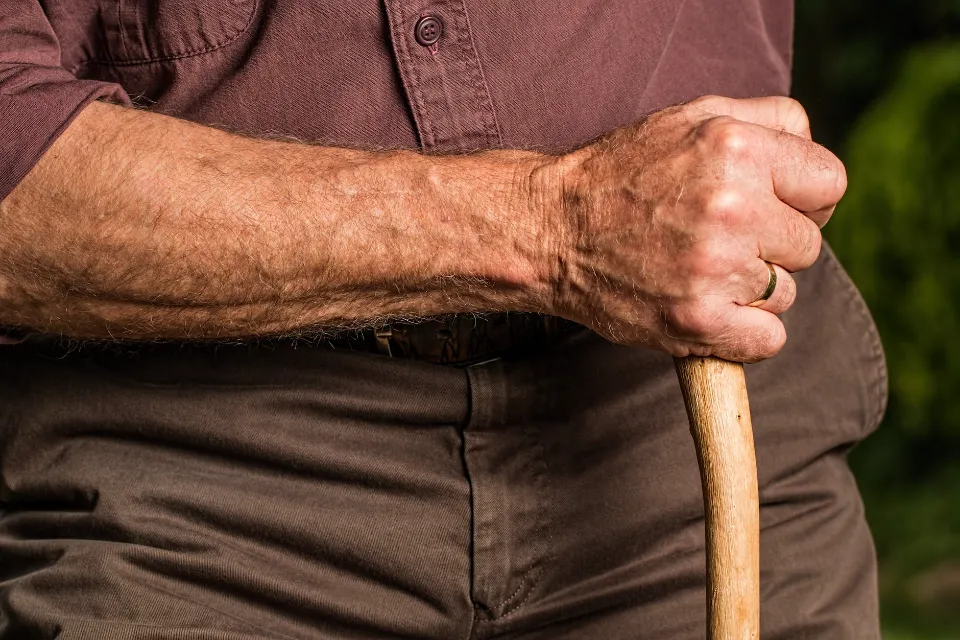A walking cane can be a long-term or temporary fix. If you have a chronic illness that makes you dependent on a cane, you might need one for a while after an accident or injury or you might always have one with you.
If you’re between 76 and 79 inches tall, you should order a 38-inch cane; if you’re between 72 and 75 inches tall, you might prefer a 37-inch cane.
Use the following information only as a guide because, due to individual preferences, determining height is not always an exact science.
Related: How to Measure for a Cane: Step by Step – Elder VIP
Different Types of Canes
The best results from a cane come from properly sizing and adjusting it.2 Canes are typically made of wood or metal.
Metal Canes
The majority of metal canes are movable. Simply unfasten the tension screw located near the bottom and press the tiny button on the cane’s side. The cane’s metal components can then be moved to adjust its length.
Don’t forget to tighten the tension screw after you’re done and to make sure the push button is completely seated in the hole.

Wooden Canes
If your cane is made of wood, you can shorten it by trimming off the appropriate amount at the bottom. A wooden cane cannot be made longer, so take care not to cut it too much. A good rule to follow is “measure twice, cut once.”
How Long Should a Cane Be?
To ascertain the length of a cane you require, follow the steps below.
Estimating Your Cane Length
You can use your height as a general guide to determine the size you might need if you’re ordering a cane online without a tape measure. A person between 76 and 79 inches tall should order a 38-inch cane, whereas someone between 72 and 75 inches tall might prefer a 37-inch cane. For every three inches you fall below the recommended height ranges, the length of the cane you order should decrease by one inch. For instance, a person who is between 64 and 67 inches tall should purchase a 35-inch cane.
If you’re about average height, order a 36-inch cane. The majority of canes are made or adjusted to be 36 inches (91.4 cm) in length because many people (particularly men) fall within the height range of 68–71 inches (170–180 cm). Some cane manufacturers automatically send 36-inch canes to online customers unless they request a different length.
The elbow, shoulder, and neck are particularly susceptible to pain when using a cane that is either too long or too short.
Take a cane from a person who is your size. Ask a friend or family member who is the same height as you if you can borrow or buy their cane if they needed one temporarily to recover from an accident or injury. If they were properly measured for the cane and have a similar shoe-wearing pattern to you, then their cane might be a great fit for you.
Use a Measuring Tape
By measuring the distance between your hand and the ground while you are wearing shoes, you can determine the ideal cane length for you. The top of your cane should match the crease in your wrist when your arm is hanging straight down by your side. In other words, the length of your cane should be equal to the distance between your wrist and the ground.
If your posture is stooped, measure differently. If you have a medical condition that makes it difficult for you to stand up straight, you should think about measuring yourself differently. You’ll probably need a shorter cane in this situation than you would normally need to be given your height. So, as you walk while wearing shoes, gauge the distance between the ground and the location of your wrist. If necessary, ask a friend to assist.
Enlist the aid of an expert. The best course of action is to ask your doctor or physical therapist for assistance if you find it too challenging to take the correct measurements for your walking cane. Consider requesting a prescription for a cane from your physician. Additionally, you might want to visit a medical supply store and ask a salesperson to assist you in choosing the best cane for your needs. The best material for your cane, along with the shape of the handle and the preferred grip, can all be suggested by your doctor or a salesperson.
Considering Your Options
Examine various cane lengths. Although measuring the distance from your wrist to the floor is the “gold standard” of determining cane length, you may prefer a slightly different height based on many physiological factors, such as the flexibility or strength in your hands, wrists, elbows or shoulders. For instance, you might require a cane that is a little shorter if you have limited elbow flexion.
Keep in mind the purpose of your cane. In contrast to needing a cane to support the majority of their body weight, many people who carry one use it primarily for balance (especially when walking on uneven or slippery surfaces). If you intend to use your cane primarily for balance rather than weight bearing or support, you don’t need to be as exact with its length.
Select a grip that is comfortable for you. There are various grip styles available for canes. You can, for instance, purchase a cane with a foam handle grip and an arm cuff that fits around your arm. To make it simpler for you to hold onto, you can also purchase a cane with a large handle.
Don’t overlook the advice. Typically, walking canes have rubber or plastic tips on the end that offer grip but also change the height of the cane. Because of this, always account for the size of the tip when measuring the cane. Additionally, the cane’s height will slightly decrease as the tips deteriorate with use, so be sure to replace them.

Don’t Use a Cane Wrong
Your functional mobility and safety may be compromised if your cane is not properly sized.
If your cane is too long, it won’t give you the support you need as you walk. If it’s too small, you might slouch forward. Your center of mass may shift forward as a result of this, which could result in back pain as well as balance issues and possible falls.
Take the time necessary to size your cane properly.
Conclusion
Crutches can help you maintain your mobility and balance if you are unable to walk due to an illness or injury. You have a variety of options, and your physical therapist can assist you in selecting the best one.
Your physical therapist can also assist in making sure your cane is the proper height and that you are using it properly. The general guidelines offered here are meant to explain why the type and height of the cane are significant as well as how to use the cane without running into issues.



